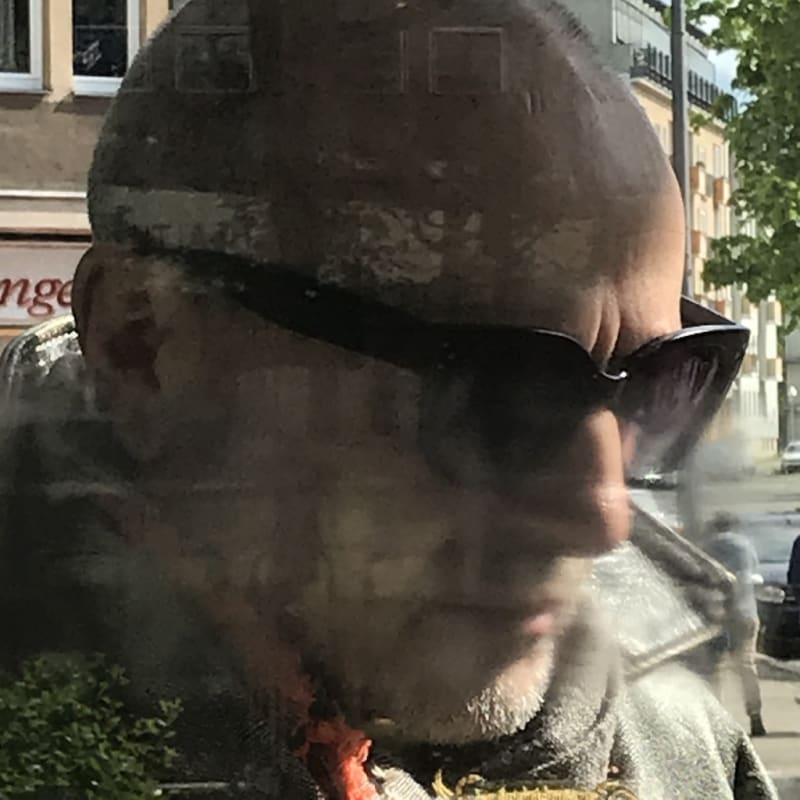The works of Evgeniy Dybsky (b. 1955 in Constanza, Romania) simultaneously combine several types of plastic art, belonging to the space of painting, graphics, installation, and sculpture at the same time. The artist changes the idea of the existence of a painting in two dimensions, going beyond the plane of the canvas or another support, achieving three-dimensionality and experimenting with the chemical and physical properties of various materials and their combinations. Started discovering the border and the links between figurative painting and abstraction while creating a series of Cremea paysages in 1985 in series “Alarming space”, Dybsky continues his research of interconnection between these two sides of representation and perception through all his artistic career.
The process of creating Dybsky's composition is at once a construction and work not only with classical painting materials, but also with optics, the physical properties of light, and mechanics. The artist builds compositions by considering the work as initially three-dimensional and integrating three-dimensional elements and objects into the main surface of the work.
Characteristic of the artist’s pictorial language is the conventional division of the composition of the work into zones, each of which is created with materials of different plasticity and density. Densely painted and sometimes almost sculpted fragments contrast with translucent color mix and drawings made in charcoal or sanguine on an unprimed canvas.
The chemical formula of the painting material of Dybsky’s works is unique and created as an outcome of many years of research; the colorful matter undergoes an “alchemical” transformation and often includes “ingredients” that are not typical for classical formula of oil or acrylic.
The volume and multidimensionality created by the author exist not in an illusory and pictorial form, but in a physical and real one, which makes it possible to see elements of sculpture and installation in the works. Dybsky’s compositions result from a multilayered and multicycle creation process which for some pieces takes several years to complete.
Through all his career Dybsky continues the series “Translation of Time” which carries and reflect the main idea and philosophy of his works – the transcendental character of an art object which accumulates time during its creation and existence and encloses in its body compressed information and the transformations being recorded permanently with the flow of time. The artist avoids giving the titles to his works, they carry only numbers and create a kind of mathematical sequence with numbers growing from the beginning towards infinity.
Born in 1955 in Romania, Evgeni Dybsky graduated from Moscow Art School in 1978 and Moscow Academical Art Institute named after V. Surikov (RU) in 1984. He lived and worked in Italy and Germany (1990 – 1996), in 1996 the artist moved to Cologne, since 2009 Evgeni Dybsky lives and works in Berlin (DE).
Evgeni Dybsky’s works are in the collections of:
The State Hermitage Museum, St. Petersburg (RU),The State Russian Museum, St. Petersburg (RU), Academy of Arts, Moscow (RU), Novosibirsk State Art Museum (RU), Kunsthalle Stiftung Henri Nannen, Emden (DE), Stiftung Ludwig (DE), Stiftung Burg Kniphausen, Wilhemshaven (DE), Zimmerli Museum, New-Jersey City (USA), Museum of History of Moscow, Moscow (RU), Moscow Museum of Modern Art, Moscow (RU), Kunstsammlung Nordrhein-Westfalen, Kornelimünster, Aachen (DE), International Museum of Persecuted Art, Ashdod (IL), State Center of Contemporary Art (RU), Museo di Arte Contemporanea, Rovereto (IT), Fondazione Marconi, Milan (IT),
Fondazione Biscozzi | Rimbaud, Lecce (IT),
and in private collections in USA, France, Great Britain, Germany, Italy, Holland, Sweden, Belgium, Greece, Israel, Portugal, Poland, Brazil, Russia, Finland.
Selected solo exhibitions include among others:
"Giotto Project" Moscow Museum of Modern Art (RU) (cataloque) 2013; Museum Ludwig, Koblenz (DE) (catalogue), 2009; Museum Synagoge Gröbzig, Gröbzig (DE), 2009; Kunst aus Nordrhein-Westfallen, Aachen (DE) (catalogue),2008; Gallery Ruarts, Moscow (RU), 2008; Gallery Filisetti Arte Contemporanea, Caravaggio (IT),2008; Galiery Sandmann, Berlin (DE), 2006; Museum Synagoge Gröbzig, Gröbzig (DE), 2005; Museum of Modern Art, Moscow (RU) (cataloque), 2005; Gallery Henseleit - Buchholz, Cologne (DE), 2005; Rheinisches Landesmuseum Bonn (DE) (cataloque), 2004; Stiftung Gerhard-Hauptmann-Haus, Düsseldorf (DE), 2004; IZO Gallery, London (UK), 2004; The State Tretyakov Gallery, Moscow (RU) (cataloque), 2003; Ludwig Museum in the Russian Museum, St Petersburg (RU) (cataloque), 2003.
